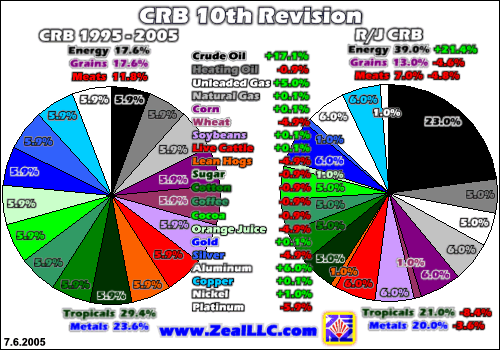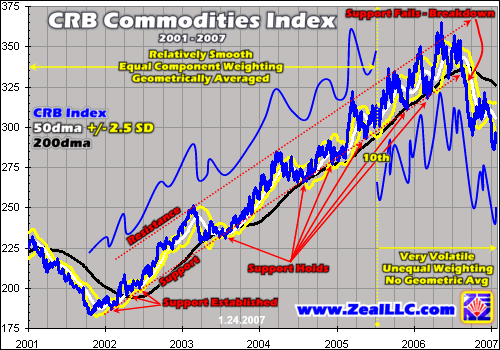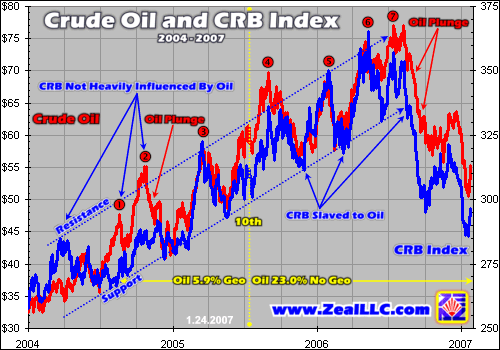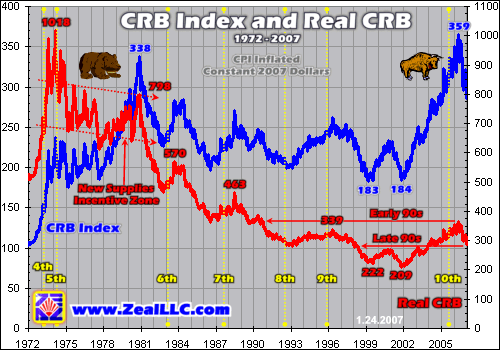CRB Dominated by Oil
Adam Hamilton January 26, 2007 3461 Words
Until this week, many of the trading days in January have been just another turn of the screw for beleaguered commodities investors. With prices falling and psychology dismal, countless bearish theories have taken root like weeds in the fertile pessimistic soil. The ranks of even the incorrigible commodities bulls have thinned.
Yet over the last few days, like a warm spring breeze bringing hope for the end of winter, we’ve seen some nice gains in key commodities’ prices. Rising prices, even for a short spell, do wonders to pry the icy black fingers of bearish fear off the hearts of investors. With excessive bearishness bleeding off, finally investors can rationally consider commodities again.
I want to exploit this island of rationality amidst a sea of gloom and doom to try and kill a dangerous bearish falsehood that is misleading many. Just as a carefully crafted heresy can sway the hearts of even the long-time faithful, this particular bearish notion is wreaking havoc among even the long-time commodities investors. It is best we drive a jagged wooden stake through its heart and send it back to the obscurity it deserves.
This dangerous theory is the widespread notion today that the long-term commodities uptrend has been broken so this bull market is technically over. Since it only takes a chartist two minutes to demonstrate this on a CRB Commodities Index chart, this pernicious idea is spreading like wildfire. It looks sound on paper, but a critical flaw exists in this thesis that negates it outright. Sadly since few know of this flaw, this false idea has hoodwinked many.
The show-stopping problem with the now infamous broken secular support line of the CRB has to do with this flagship index’s composition. As I will explain in this essay, the CRB index that generated the major support line that failed in recent quarters no longer exists. The new CRB index that replaced the old CRB is radically different in construction and execution and totally incomparable. It is worse than comparing apples and oranges.
Interestingly stock guys totally understand that indexes change. Stocks are added and removed from the S&P 500 and NASDAQ 100 all the time. Interestingly in the NASDAQ 100’s case, of the 100 component companies that were in this flagship technology-stock index near its early 2000 secular high, only 39 remain in it today. It is wild to realize that 61% of 2000’s elite tech stocks have been booted from their elite index!
But commodities guys, probably because there aren’t that many commodities around relative to the thousands of stocks, seem to overlook the fact that indexes change. The flagship CRB index has actually had ten major revisions since it was launched in 1957. Just like a stock index, a commodities index has to change in order to keep up with the times and fairly reflect today’s, not yesterday’s, key commodities.
Although having a changing yardstick creates obvious problems of comparability, not having one leads to obsolescence and irrelevance. For example, of the 28 commodities included in the original CRB of 1957, there are quite a few that just aren’t relevant at all in our modern economy. Can you imagine if rye, potatoes, onions, hides, and lard were still in the CRB today? It would be laughed out of the markets! Lard?!?
Historically when the CRB was periodically revised over the last 50 years, the changes involved component switching/adding/removing only. For example, in the CRB’s 4th major revision in 1973, lard (among other commodities) was removed and coffee was added. Coffee, a commodity more critical than water for many people these days, has remained in the CRB since. It is a far better component choice for today’s economy than lard.
Nine times after the CRB was introduced a half-century ago, periodic revisions happened where fading older commodities were swapped out for other ones with rising usage and importance. Yet over all that time between 1957 and 2005, the calculation methodology for the CRB essentially remained the same. All component commodities were equally weighted and geometrically averaged. This geometric averaging, across all components’ prices collectively, banished extreme volatility from this index.
But in mid-2005, in the CRB’s tenth revision, an incredibly radical change took place. Not only was the CRB’s list of individual components adjusted as usual, but its entire calculation methodology was truly radically changed into something new never before seen in this index. The equal weighting and traditional geometric averaging that were used for the first 48 years of the CRB’s life were thrown out the window.
Each one of these core calculation-methodology changes alone would have rendered the CRB highly incomparable to its entire history, but both of them together created an entirely new index. It is not at all comparable to its previous half-century. Provocatively the CRB’s secular uptrend support line that just failed, terrifying commodities investors, straddled this radical tenth revision.
Before we get into the notorious technicals that are misleading investors, it is important to consider the tenth CRB’s typical component and unprecedented weighting changes. Right before this tenth revision went live in July 2005, I wrote an essay discussing it in depth. This chart is lifted right out of that earlier essay and is tremendously important to understand if the CRB’s recent behavior concerns you.

In the 48 years before the tenth revision, all components had equal weighting in a perfectly sliced pie. But in the tenth revision a monster arose and consumed much of the pie, kind of like me every Thanksgiving. The weight of crude oil was radically raised to 23.0% of the entire CRB index, compared to the mere 5.9% it had commanded since it was first inducted into the CRB in 1983.
Now please realize I believe this increase in oil’s weighting is totally justified. It is absolutely the King of Commodities today. It forms the foundation of our extensive global trade and hence the entire world economy. Virtually everything we consume in the first world is transported via oil-powered ships, trains, trucks, and airplanes. Without oil, the incredibly intricate global logistics network on which we so heavily rely today would grind to a halt. We would be thrust back into the Steam Age before flight and global trade would implode. Oil’s supreme importance is unassailable.
This being said, the fact is today’s CRB is radically different from all the CRB history that came before it. And believe it or not, the 5.9% to 23.0% increase in oil understates this case. In today’s CRB, both heating oil and unleaded gasoline are also included. But of course both of these crucial commodities are refined from oil and hence directly dependent on oil’s pricing. Since gasoline wasn’t in the ninth CRB revision, the effective weight of oil products soared from 11.8% to 33.0% in the tenth revision.
Thus today oil effectively dominates the CRB comprising a full third of its weight! 33% is an enormous weighting in an index. For a comparison, tech-stock traders know that the NASDAQ 100 is heavily dependent on Microsoft’s fortunes since it is the biggest tech stock on the planet. But even that tech monolith only accounted for 13% of the NASDAQ 100’s market cap as this year dawned. At 33%, oil is the CRB!
This crucial fact has enormous implications for anyone who watches the CRB. Before July 2005 oil played a small role in the CRB in line with that of its commodity peers. Since July 2005, oil has been weighted 5.5x to 33.0x times higher than any other individual commodity component. Before the tenth revision, the other commodities could override oil if they were moving in different directions. Today oil’s CRB dominance is virtually unchallenged.
Now these huge weighting changes alone would render the CRB incomparable to its past, but the jettisoning of the traditional geometric averaging means we have an entirely new index since mid-2005. Geometric averaging vastly reduces the impact that any one component’s price can have. It results in a tremendous smoothing that creates a calm and lazily meandering index. The new arithmetic averaging removes this excessive smoothing to create an index far more responsive to price moves in any individual component.
And indeed, just as the underlying math predicts this is exactly what we’ve seen since the tenth revision. This chart shows the history of this commodities bull in CRB terms, including the now infamous broken secular support line that is igniting so much angst. The behavior of the ninth CRB revision before July 2005 and the tenth CRB revision since is radically different. They are not even close to being the same animal anymore.

The CRB itself continued its tight secular uptrend for a little over a year after its tenth revision was made. But based on what I know about the CRB’s construction and the radical changes that took place in mid-2005, I suspect this apparent trend continuity is more coincidence than anything else. Yes, support on the tenth CRB revision failed last autumn, but this support line for the new CRB was only valid back to its July 2005 creation, not to this bull’s birth in late 2001.
The raw difference in volatility that the end of geometric averaging yielded is really pretty stunning. In this chart, I traced the CRB both before and after its tenth revision with a smoothed line. You can see these lines offset away from the CRB itself. This volatility approximation prior to July 2005 is very smooth and sedate, generally meandering lazily with sharp moves between support and resistance few and far between.
But after mid-2005, the volatility approximation line for the CRB started jumping around aggressively. Now oil, itself very volatile, effectively made up a third of this index and there was no more geometric smoothing anyway to throttle down extreme price movements in any component. The CRB started jumping around in its perceived continuing uptrend channel like a little kid who just ate a plate of cookies and has pure sugar flowing through his veins.
Since the behavior and volatility characteristics of the CRB were radically different before and after the tenth revision, it is totally irrational to extend the same trend lines across that vast change. The fearmongering technicians doing this, regardless of through ignorance or malice, are comparing apples to oranges. The CRB since its tenth revision is an entirely new index with no comparable roots in the past and no history.
The way this new CRB is constructed, it has no choice but to immediately and completely bow to the will of oil. If oil is strong the CRB will thrive, and if oil is weak it will suffer. Ultimately the CRB’s notorious support breakdown is merely a reflection of the tremendous correction we’ve witnessed in oil over the last six months. Many other commodities have been relatively strong compared to the horrific carnage in the oil pits.
Oil’s bull market really didn’t start firing on all cylinders until 2004, when it finally climbed above $30 for good. This next chart examines oil and the CRB since then, a rather convenient span of time for our purposes today since the tenth revision is right near the middle. There are very clear differences between how the CRB interacted with the oil price in its ninth-revision days compared to the last 18 months of tenth-revision action.

With the oil complex being weighted at 11.8% in the ninth CRB revision yet geometrically smoothed, the CRB was not heavily influenced by oil. In 2004 alone for example, we see a strong CRB rally while oil was largely flat and a couple of quarters later a strong oil rally while the CRB was largely flat. Even more tellingly, when oil plunged in late 2004 the CRB actually rose during the first half of this huge swoon! Why? Other component commodities were thriving and they outweighed the struggling oil price.
But since the tenth revision with the oil complex weighing in at a hefty 33.0%, the CRB is slaved to oil. Today the CRB cannot do anything unless oil does it first. This, along with the straight arithmetic averaging, has led to vastly more volatility in the CRB that perfectly matches that of oil like a key in a lock. So when oil started plunging late last summer, the tenth CRB revision had no choice but to plummet in sympathy, quite unlike in 2004 when the CRB ignored another massive oil plunge.
The big “secular” CRB support line break shown above that is tormenting commodities investors is really nothing more than a massive oil correction. Yes, this oil correction is easily the biggest of oil’s bull market, but what can we expect in the warmest year in the US in over a century? We had an anomalously very warm winter in the States, a rare event, so oil-complex demand fell, inventories rose, and prices sold off.
The CRB “breakdown” is merely a reflection of the problems in the oil market, not commodities as a whole. When investors look at the CRB today, they should just think “oil”. Oil utterly dominates this index now and it will continue to do so until the CRB’s methodology and weighting change. And flagging oil fortunes due to an amazingly warm winter do not translate into fundamental problems across the board in commodities. This is oil-and-gas specific only.
I hate falsehoods and it really irritates me when market commentators mislead investors due to insufficient research. If they are going to guess on the future and be wrong, fine, that is speculation. But to bring up a CRB chart, show a dire long-term support breakdown, but conveniently fail to mention that they are really looking at two radically different indexes, is unacceptable. To me it reeks of gross negligence or fraud.
As I write about this issue publicly and in my newsletters to try and help investors really understand what is up with the CRB, I invariably get questions asking why I don’t reconstruct the ninth-CRB-revision methodology myself and graph it out to today to compare with the tenth CRB revision. Believe me, I really want to. Unfortunately I lack the mental firepower to pull it off so some mind far superior to my own will have to do it. Here is the problem for me on ninth-CRB-revision reconstruction.
I am a student of the markets and love this stuff, but I have never seen another index even remotely close to the complexity of the old CRB. First, it didn’t just use one commodity price, it used many simultaneously. We’ll use oil for this example. The old CRB, multiple times a day, took the oil price across multiple oil futures contracts expiring within the next six months. Then it arithmetically averaged them. So a reconstruction would require extensive historical daily data from all futures contracts for each component commodity simultaneously and a hideously complex spreadsheet to run the numbers.
And if it is possible to reconstruct this first part of the old CRB, individual component “pricing” daily, then the second part must be undertaken. Each individual component price, itself an average of many futures prices, has to be equally weighted and then geometrically averaged with the other components. All this is possible, but getting the raw data historically for a broad array of futures simultaneously and properly crunching the data would be a Herculean task at best. And the result would probably only approximate a hypothetical extended ninth CRB revision.
So I would love to see what the ninth CRB revision would look like extended to today. I hope someone out there can build it. I know this for sure, the CRB breakdown would either be vastly smaller, a minor dip under its long-term support, or it would not exist at all. While crude oil is important, it is not the only commodity in existence. And all commodities trade independently on their own inherent individual supply-and-demand fundamentals.
Most of the time when I have seen bears use the CRB support breakdown to frighten people, they have used it in the context of declaring that it must mean the secular commodities bull is over. But even this raw technical premise is flawed. In a secular bull market, all a correction means is that there is a temporary surplus of either supply or greed. Once this temporary imbalance is rectified, the long-term bull will continue if fundamentals remain intact. Oil’s bull is not over fundamentally, not by a long shot, and the warm-winter disruptions will be absorbed sooner or later.
The bears also claim that commodities were at an all-time high last spring and therefore their bulls have run their courses. Nonsense. Thanks to the ever-inflating fiat-paper money supplies in the US and around the world, valid multi-decade comparisons cannot be made in nominal dollars. To compare today’s commodities bull with that of the 1970s, inflation must be considered. Although conservative since it understates true monetary inflation, I am using the US Consumer Price Index as my inflation proxy in this next chart.
The blue line is the nominal, unadjusted CRB that the bears are fretting over. Yes it looks high compared to the 1970s. But the red line is the CPI-inflation-adjusted CRB, and shows the true state of commodities prices today given the vast decline in the purchasing power of each US dollar thanks to the Fed’s prolific printing presses. In proper monetary context, the action prior to the recent CRB carnage looks merely like a modest initial upleg of a long secular bull!

Even at its top last spring, the real inflation-adjusted CRB was only near early-1990s commodities prices. And as you can see above, those early-1990s prices were already very low after decades of sliding real commodities prices. Today, after the sharp correction in the CRB since last summer, the index is merely back to late-1990s levels. This is not too far above the secular commodities lows of late 2001! Commodities remain very cheap today!
To see real commodities prices comparable to those of the 1970s, the CRB would have to climb near 800 to hit early-1980s real price levels and even higher to hit the real prices seen shortly after Nixon severed the last remaining vestige of the US gold standard back in the summer of 1971. And really, since the tenth CRB revision is so radically different from the nine before it, who knows how high it will go this time around? I guess it depends on how high oil’s bull ultimately carries it.
One more thing to note here. I drew in previous CRB revisions on this chart, although all were trivial component swaps/additions/deletions compared to what we saw in the summer of 2005. All indexes periodically change over time and such changes need not cause anxiety. Modifying the CRB, or indeed any index, is simply par for the course as time relentlessly marches on and economies and markets evolve.
While I do love comparability as a student of the markets, I ultimately think the radical changes in the CRB at its tenth revision are good. Nothing attracts investors to new markets quicker than volatile prices that are rising on balance. Without all the excessive geometric smoothing of the old CRB, which I never liked, it will be free to experience far larger and more exciting moves than would have been possible in the old CRB. And big up moves will really capture mainstream investors’ attention and affections.
At Zeal we very much believe the secular commodities bulls are alive and well, including oil’s. Lately we have been focusing much of our attention on gold and silver though, as the precious metals seem to be early on in major new uplegs that should yield tremendous profits. If you are interesting in seeing our latest recommendations for high-potential gold-stock trades, please subscribe to our acclaimed monthly newsletter today. January’s fears have yielded an awesome time to load up on elite precious-metals stocks.
The bottom line is the CRB index radically changed in mid-2005, and severed all ties with its illustrious past. The oil complex now accounts for a third of this index and utterly dominates it. The alleged CRB breakdown advanced by fearmongers is not secular as it is only valid for the tenth CRB revision, or a little over a year. All it proves is there was a huge oil correction on an extremely anomalous warm winter.
If you are a commodities investor, I urge you to look at the fundamentals and not be misled by technicians who are not telling you the truth about the radically different CRB. Some are naďve and don’t know this, much to their embarrassment I hope, but others have hidden bearish agendas. The reality is today’s secular commodities bulls are far from over because commodities’ long-term structural supply deficits still persist.
Adam Hamilton, CPA January 26, 2007 Subscribe at www.zealllc.com/subscribe.htm
![]()